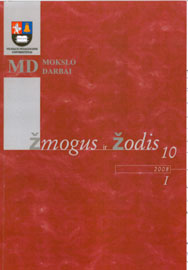Priebalsines priesagas turinčių išvestinių vardažodžių šaknies balsių kaita
Root Vowel Change in Derivatives with Consonant Suffixes
Author(s): Gražina AkelaitienėSubject(s): Language and Literature Studies
Published by: Vytauto Didžiojo Universitetas
Keywords: consonant suffixes; derivate word; segmental morphonological vowel change; morphonological diphthongization and monophthongization
Summary/Abstract: The article analyses one of the morphonological phenomena, i.e. segmental morphonological vowel change which occurs in word roots after the addition of formants starting with a consonant. Consonant suffixes cause the modifications of a word’s base form less frequently than endings but more often than vowel suffixes. These modifications, motivated by consonant suffixes, cannot be attributed only to the stem’s ability to adapt (derivatives’ morphonological characteristic); this could also be treated as a formant’s complementary component (morphonological marker). It should be noted that consonant suffixes most often determine the vowel alternation in a verb stem. The realization of formants in morphonologically marked derivatives is not varied: they usually contain suffixes starting with the phoneme /t/; in some cases this phoneme appears in some other position. Consonant formants very often presuppose the alternation /e/:/a/; however, this change does not exclude other phonemic variations, for example, /e/: /i/ (gérti – girtas, gilùs - gelmė), /i/:/a/ (rijo – rajùs). Our morphophonological system displays, in addition to monophonemic segments, the cases of interchange of a phoneme and phonemic combinations. Morphonological diphthongization as well as monophthongization are not diverse; they are usually realized through the same morphophonemes, e.g. <au/ū> (spūstis, ūgis, pjūtis) or <ie/ai> (saitas, sráigtas, šlaitas). The morphophonemes which occur in these consonant suffix derivatives are the most productive, i.e. they belong to the morphophonemes functioning in the majority of roots.
Journal: Žmogus ir žodis
- Issue Year: 10/2008
- Issue No: 1
- Page Range: 5-8
- Page Count: 4
- Language: Lithuanian

